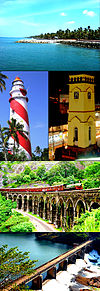
Vyasa is the author of the Mahabharata, Vedas and Puranas, some of the most important works in the Hindu tradition. He is also called Veda Vyāsa or Krishna Dvaipāyana.

Srikalahasti Temple is located in the town of Srikalahasti, in the state of Andhra Pradesh, India. It is one of the most famous Shiva temples in South India, and is said to be the site where Kannappa was ready to offer both his eyes to cover blood flowing from the Siva linga before the Siva stopped him and granted him moksha.

Banganga, Banganga Talav or Banganga Tank, is an ancient water tank which is part of the Walkeshwar Temple Complex in Malabar Hill area of Mumbai in India.

Kashi Vishwanath Temple is one of the most famous Hindu temples dedicated to Lord Shiva. It is located in Vishwanath Gali of Varanasi, Uttar Pradesh, India. The Temple stands on the western bank of the holy river Ganga, and is one of the twelve Jyotirlingas, the holiest of Shiva Temples. The main deity is known by the names Shri Vishwanath and Vishweshwara literally meaning Lord of the Universe. Varanasi city is also called Kashi in ancient time, and hence the Temple is popularly called as Kashi Vishwanath Temple. The etymology of the name Vishveshvara is Vishva: Universe, Ishvara: lord, one who has dominion.
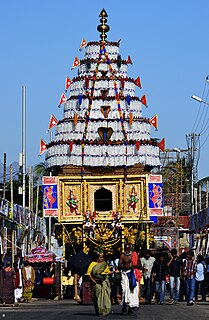
Kalpathi (Kalpathy) Ratholsavam is an annual Hindu Temple festival in the Kalpathi village of Palakkad district in Kerala state, south India. The festival is at the Sri Visalakshi Sametha Sri Viswanatha Swamy temple where the deities are Lord Siva and his consort Visalakshi, another name for Parvati.

Antara Gange is a mountain situated in the Shathashrunga mountain range in the southeastern portion of the Indian state of Karnataka, Kolar district. Antara Gange literally means "Ganges from deep" in Kannada. It is about two miles from the town of Kolar and seventy kilometers from Bangalore. Antara Gange is famous for Sri Kashi Vishweshwara temple, also known as Kashi of South. The temple is dedicated to Lord Shiva. In the temple is a pond which gets a continuous flow of underground water from the mouth of a Basava. It is believed that drinking water from the pond cleanse one from many diseases.

Kaleshwaram is a village in Mahadevpur Mandal in Jayashankar Bhupalpally district in the Indian state of Telangana. This name refers more broadly to the state of Telangana & Kaleshwaram Temple.
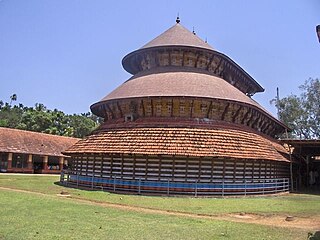
Madhur Sree Madanantheshwara-Siddhivinayaka Temple is a popular Shiva and Ganapathi temple located 7 km (4.3 mi) from Kasaragod town, on the banks of Mogral river, locally known as Madhuvahini. Though the main deity of this temple is Lord Shiva known as Madanantheshwara, meaning the god who killed Kama, the god of desires, more importance is given to Lord Ganapathi, who is installed facing south in the main sanctum itself. Priests of this temple belong to the Shivalli Brahmin community. Kashi Vishwanatha, Dharmasastha, Subrahmanya, Durga Parameshwari, Veerabhadra and Gulika are the sub-deities of this temple. There is also presence of Goddess Parvati inside the main sanctum.
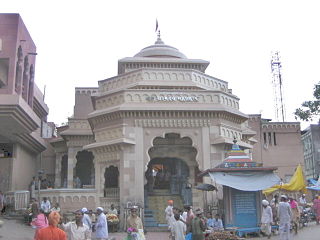
The Vithoba Temple, officially known as Shri Vitthal-Rukmini Mandir (Marathi: श्री विठ्ठल-रूक्मिणी मंदिर, is a Hindu temple in Pandharpur in the Indian state of Maharashtra. It is the main centre of worship for Vithoba, a form of the god Vishnu or Krishna, and his consort Rakhumai. It is the most visited temple in Maharashtra. The Warkaris start marching from their homes to the temple of Pandharpur in groups called Dindi to reach on Aashadhi Ekadashi and Kartiki Ekadashi. A dip in the holy river Chandrabhaga, on whose banks Pandharpur resides, is believed to have power to wash all sins. All the devotees are allowed to touch the feet of the idol of Vithoba. In May 2014, the temple became the first in India to invite women and people from backward classes as priests.
Guptakashi, Gupta Kashi or Guptkashi is a fairly large town located at an elevation of 1,319 metres (4,327 ft) in the Kedar-khanda, in Garhwal Himalayas of Rudraprayag district in Uttrakhand, India. It is known for its ancient Vishwanath Temple dedicated to the god Shiva, which is similar to the one in Varanasi (Kashi). The other well known temple here is dedicated to Ardhanareshvara, a half man half woman form of Shiva and Parvati. The name Guptakashi has legendary significance linked to the Pandavas, the heroes of the Hindu epic Mahabharata. Its religious importance is considered next to that of Varanasi, believed to be the most pious of all Hindu pilgrimage sites.

The Mahabaleshwar Temple, Gokarna is a 4th-century CE Hindu temple located in Gokarna, Uttara Kannada district, Karnataka state, India which is built in the classical Dravidian architectural style. It is a site of religious pilgrimage. The temple faces the Karwar city beach on the Arabian Sea in which Hindu pilgrims cleanse before visiting the temple for worship. The temple is considered as holy as the Shiva temple at Varanasi or Kāśi (Kashi) in North India on the banks of the Ganges River. Hence, the Mahabaleshwar temple, Gokarna is known as the Dakshin Kasi. The temple deifies the Pranalinga also called Atmalinga or Shiva Linga In legend, it is said that the deity of the temple will bestow immense blessings to devotees, even to those who only glimpse it. Currently the administrative charge of the temple is with Sri Ramachandrapura Mutt, as per the guidance of Adiguru Shankaracharya during the establishment of the Matha.
Kadugodi is a suburb located in Whitefield, Bangalore in the state of Karnataka, India. The area is said to have been founded over 1000 years ago by the Chola dynasty.
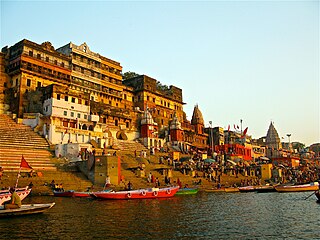
Ghats in Varanasi are riverfront steps leading to the banks of the River Ganges. The city has 88 ghats. Most of the ghats are bathing and puja ceremony ghats, while two ghats are used exclusively as cremation sites.

The Gyanvapi mosque is located in Varanasi, Uttar Pradesh, India. It was constructed by the Mughal Emperor Aurangzeb after destroying the hindu temple of Kashi Vishwanath.

Shivagange is a mountain peak with a height of 1300 metres and Hindu pilgrimage center located near Dobbaspet, in Bengaluru Rural district India. It is situated 19 km from the town of Tumakuru and 54 km from Bengaluru. The sacred mountain is shaped as a shivalinga and a spring flows near locally called "Ganga", thereby giving the place its name. It is also known as Dakshina Kashi and has various temples such as Gangadhareshwara temple, Sri Honnammadevi Temple, Olakal Teertha, Nandi Statue, Patalagang Sharadambe temple and several theerthas such as Agasthya theertha, Kanva theertha, Kapila theertha, Pathala Gange

Varanasi, also known as Benares, Banaras, or Kashi, is a city on the banks of the river Ganges in Uttar Pradesh, India, 320 kilometres (200 mi) south-east of the state capital, Lucknow, and 121 kilometres (75 mi) east of Allahabad. A major religious hub in India, it is the holiest of the seven sacred cities in Hinduism and Jainism, and played an important role in the development of Buddhism and Ravidassia. Varanasi lies along National Highway 2, and is served by Varanasi Junction railway station and Lal Bahadur Shastri International Airport.
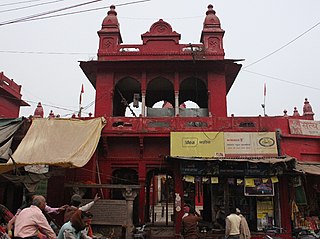
Durga Mandir, also known as Durga Kund Mandir and Durga Temple, is one of the most famous temples in the holy city of Varanasi. This temple has great religious importance in Hinduism and is dedicated to the Maa Durga. Durga Mandir was constructed in 18th century by Rani Bhabani of Natore.

Shri Vishwanath Mandir also known as Vishwanath Mandir, Vishwanath Temple, New Vishwanath Temple and Birla Temple is one of the most famous temples and biggest tourist attractions in the holy city of Varanasi. The temple is situated in Benaras Hindu University and is dedicated to the Lord Shiva. Shri Vishwanath Mandir has the tallest temple tower in the world with the Vimana's height being around 250 feet.
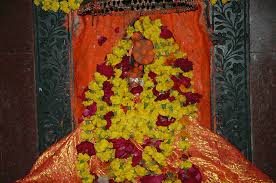
Lalita Gauri Mandir, also known as Lalita Mata Mandir, is one of the important and historic temples in the holy city of Varanasi. This temple has great religious importance in Hinduism and is dedicated to the goddess Lalita Gauri. The Mandir was constructed in early 19th century. The temple was constructed between 1800–1804 by Rana Bahadur Shah. Lalita Gauri Mandir is situated on the Lalita Ghat and the ghat was named after this temple.
Harihar Kripalu Tripathi is a Sanskrit scholar, living in Varanasi, India. He was honored with Padma Shri award by the Government of India in 2017

















